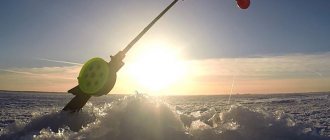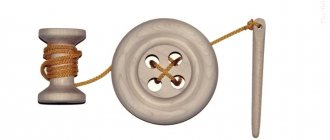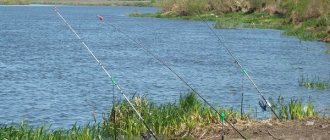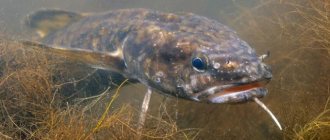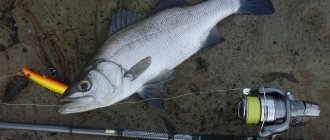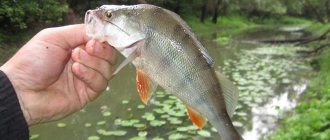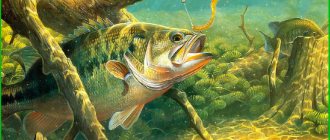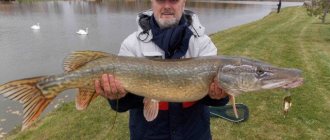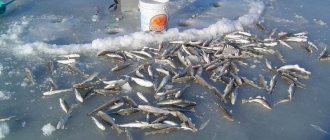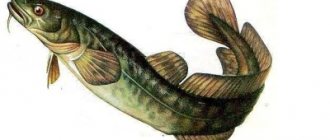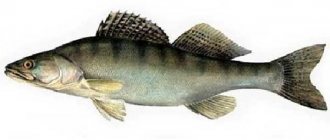Smelt is truly a cult fish for St. Petersburg, and as soon as the Gulf of Finland freezes with ice, thousands of pilgrims flock to it, and I am no exception. Because catching smelt in winter is a very exciting activity!
Already in the first days of January, I feasted on this cucumber-scented delicacy. And I will never forget the moment when, having pulled out the first caught fish from the hole, the smell of the freshest cucumbers hung in the air.
And now, in order, where, how and what to catch smelt with.
Where to catch smelt in winter on the Gulf of Finland
Every St. Petersburg fisherman has his own favorite places. For example, I prefer to catch smelt in the vicinity of the southern dam of the Gulf of Finland, these are places such as Fort Shanets, Fort Paul I, 3rd southern fort. But smelt bite throughout the entire water area of the Gulf of Finland, into which it enters from the Baltic Sea. With the onset of spring, smelt rushes to spawn in rivers. Where fishermen also lie in wait for her, but with completely different gear.
Now let’s look at the gear for catching smelt.
Choosing a fishing spot
Catching smelt in the Leningrad region depends on the choice of location. On the Gulf of Finland, my favorite places are the area of Primorsk and Vysotsk. I fish mainly at changes in depth, these are the places that attract smelt. I fish at depths of up to 20 meters. If you come to the bay and don’t know in which direction to move, you can determine where the fish are by looking at the fishermen. After all, where there is a massive concentration of fishermen, there are definitely fish.
A few words about equipment
When packing for fishing, you should take into account that you will have to walk several kilometers on ice. Therefore, you have to make do with the necessary minimum of gear and equipment. If the ice is smooth, then a sled is an irreplaceable thing, but if you don’t run on hummocks with a sled, in this case it is better to use a backpack.
I hope the information was interesting and useful for you, and if you come to St. Petersburg in winter, you will know exactly where, what and how to catch smelt in the Gulf of Finland.
Author of the article: Dmitry-Spinner
Gear for catching smelt in winter
There are many variations of winter fishing rods for smelt. Some people fish with a fishing rod, while others prefer a rod and reel. I fish with a rod and reel because of ease of transportation and depth adjustment.
There is an opinion that fishing rods with a reel are not reliable and break when hitting ice, I have never had such cases and the reel did not stick in the cold. But I do not exclude such a development of events.
For this reason, I will describe the gear based on my personal experience.
I started the season without any frills, with a standard bottom fishing rod for smelt, and now I will briefly talk about the equipment:
- Fishing rod and reel. I wind 30 meters of fishing line on a reel.
- Line Mikado Flue 0.25 mm. This acid-colored line is very visible in the snow.
- Bell weight 25 gr.
- Phosphorus jigs of various colors and sizes. I knitted jigs on leashes 2.5-3 cm.
- Lead line 0.16 mm. By the way, when the jig broke and I tied on the main line, I did not observe a decrease in bites on this fishing rod.
- Spring-ball nod

I did 2 fishing trips with these fishing rods, and then the experiments began...
The experiments began after small smelt arrived and fishing turned into some kind of crossfit. Hundreds of bites and only a few were realized. After fishing, everything hurt. It’s a pity there’s no video of me running from hole to hole and pulling out the tackle from 8 meters deep without any fish. But some people fish even at 30 meters - poor fellows.
And I decided to slightly modernize the jig for smelt, namely to make it on a double. Of course, I didn’t have a phosphor and it was decided to remove it from a ready-made jig. I just bit off the hook and took it out.
Half the job is done, all that remains is to find small doubles, and then I had to run around the city, it turns out this is not a very popular product. And hurray! I finally made a jig and went to test the tackle.
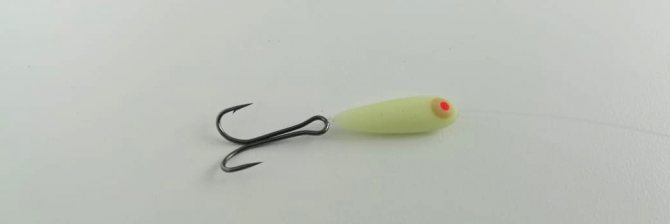
Mormyshka on a double
Imagine my disappointment when I discovered that the fish were caught no better than with ordinary smelt jigs, and sometimes even worse, since the double was constantly caught on the main line.
I had to give up these jigs; I just ruined my workers in vain.
For the next fishing trip, I decided to implement my other idea. In the store I found a heavy 22 gram spoon, coated on one side with a phosphor, and immediately pictures ran through my head of all the Baltic smelt gathering near my hole, into which my luminous spoon was lowered.

Spinner with phosphor
I removed the tee from it and tied an ordinary phosphorus jig on a small leash. I took a ready-made fishing rod and put this spinner instead of a bell weight. And with joyful thoughts he rushed off to go fishing.

Spinner with jig
I was disappointed while fishing - the bites were hard to see. If I tore the tackle off the bottom, the nod would be heavily loaded and, as a result, nothing could be seen. And if I lowered the tackle to the bottom, then for some reason the smelt preferred the jig tied to the spoon, pecked at it, felt resistance and simply threw the bait. I also abandoned this method of fishing.
But I didn’t give up experimenting with spinners. Very often the fish pecked right under the hole and I made two fishing rods with small shiny spoons that did not load the nod. I installed these fishing rods when the bites at depth stopped. And this option, as they say, “shot”. Since then, I placed the main fishing rods with a weight on the bottom, and placed one with a spinner a meter from the ice. And depending on the bite, I changed and rearranged them.

Fishing rod with spoon
When the running was over and I managed to sit on a chair for 5-10 minutes, I picked up the “spinner” and began actively catching smelt. Which is also very exciting.

Fishing rod
The equipment of the fishing rod for lures is the same as for a stationary fishing rod with a spoon, the only thing is that the spoon should be a little heavier so that it does not get carried away by the current onto the main fishing rods. After all, it is believed that you need to shine with your fishing rods, thereby attracting active fish.
Catching smelt at the Dam
Vladimir Sokolov | December 27, 2021
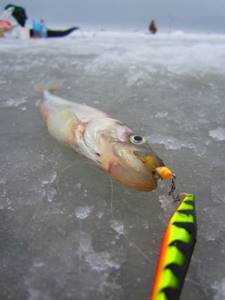
Before we start talking directly about smelt fishing, I want to remind you of the Fishing Rules for the Western Fishery Basin. In the current version of the Rules for 2021, the total number of hooks on fishing rods for sport and recreational fishing for a citizen is limited to 10 (more details).
And don’t be surprised when the news from water bodies includes information about law enforcement agencies drawing up protocols for exceeding the permitted number of hooks, even if the person failed to get closer to the catch limit. Well, the daily catch rate for an amateur is 5 kg. And now - about the introduction of new tariffs, according to which the damage caused to Mother Nature due to the catch of smelt in excess of the designated limit of 5 kg is calculated: for one extra “tail” - take out and put in 55 rubles (more details). So for frivolous citizens who do not follow the rules, smelt fishing may turn out to be - alas! - a very expensive pleasure.
I would like to end this not-so-fun introduction, but in addition I remembered that in recent years, St. Petersburg smelt fishermen have lost a significant number of what were once the most “trump” fishing spots - due to the construction of various port terminals, the laying of new fairways, as well as year-round pilotage of vessels.
Ruchi – Vistino – Logi – Cape Kolgonpya have already begun to fade in the memory of the smelt fishermen. On the southern shore of the Gulf, fishing is more or less possible up to the Garkolovo area. True, provided that the winter is frosty and the ice rises at depths of up to 15 - 20 m. In the north, the region of Primorsk and the distant banks in the area of the Berezovye Islands have “gone away”. But we cannot exclude the expansion of port construction in those places, because of which the entire Yermilov Bay may end up in the zone of year-round navigation.
However, not everything is as bad in our community as it might seem from the first lines of this story. Maybe some changes took place in nature - and large herds of smelt began to move closer to the city, to the Damba area. Or maybe, before, only locals and those especially knowledgeable knew about these places, who did not try to flaunt the hundreds of “tails” caught near the complex of protective structures.
But over time, everything secret becomes clear - and already thousands of smelt fishing lovers are rushing almost overnight to take a place in the parking lots near the Dam. True, the number of places there is limited, and even on weekdays, if you arrive at five in the morning, you may not find a place to park your car so as not to create problems for your colleagues in the evening. And in this regard, the position of the management of the “Complex of Protective Structures of St. Petersburg” is not entirely clear.
After all, you only need a little organizational effort - check, as they say, logistics, set up paid or even several paid parking lots on the Dam and its technological passages, where possible - and for the entire period of winter fishing (and not only winter fishing) a stable and very considerable income will be provided. I think the vast majority of fishermen will accept this with understanding.
In general, the Dam has seen one of the largest concentrations of smelt fishermen in the last few years. Here “Damba” is a kind of conventional concept, it means a fairly large (by the way, tested by me and my comrades) water area near the Dam - for example, at Fort Obruchev, on various banks - Popov, Tolbukhinsky, etc. After all, sometimes successful fishing can happen a few tens of meters from the Dam itself, and sometimes you have to drive 10 - 20 km away from it on various motor vehicles. And each site usually has its own specifics.
When several years ago I first came to fish at the Dam and, still in the dark, crossed the highway via the air passage to the sea side, I was surprised that the waters of the Gulf - as far as the eye could see - glowed and shimmered with multi-colored lights: all the “ruble” places were literally filled with tents. Only narrow passages are left between them. As it turned out, many of the tents had been standing in their places for several days.
And either they fish there for days on end/work on a family contract, or they are rented out. I did not clarify, but walking past the opening entrances, I noticed that fishing in the tent was organized at the highest level (photo 1) , and the life of the fishermen was arranged at the same level. And I remembered that 30 - 40 years ago in Vistino, Primorsk and other remote areas there was no fishing for days; daylight hours were enough for a good catch.
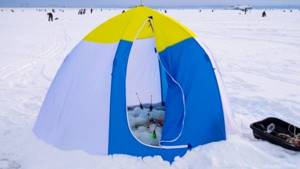
What criteria can be used to select a promising location in this water area? I think it’s impossible to do without studying maps, and for these maps to end up in a GPS navigator or tablet with a GPS module (photo 2) .
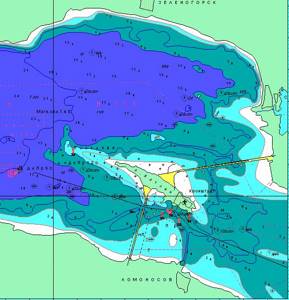
Places on the old fairway are interesting from both the city and sea sides. In the north there is the Zelenogorsk fairway, which may be interesting not far from the Pervomaisky fort. The remains of the ryazhe barrier run across the entire Gulf. Near the Dam, there are several technological fairways and all sorts of man-made accumulations, which are visible on an echo sounder or using an underwater surveillance camera (this is about the issue of electronics for finding a place).
There are several pronounced dumps and banks in the water area. Well, and the main shipping passage. I’m not advocating for it, because on some days shipping is quite intense (photo 3) - and ice movements are guaranteed not only near it, but sometimes in the winds of the southern quarter and throughout the entire water area south of Kotlin Island.
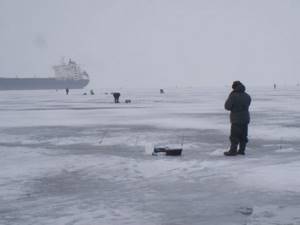
It is clear that with such a radical change in fishing locations, quite a lot has changed in fishing equipment, fishing tactics, and many other aspects. We will talk about these details further.
The approach of fishing spots to the city has made going out for such fishing much easier - as they say, for the evening. Especially if we talk about those colleagues who live near the Gulf and the Ring Road.
In the Damba area there are no those twenty or more meter depths at which most of the fish were caught in the area of Ust-Luga and Primorsk. Here the whole mystery takes place within 8 - 14 meters, occasionally at depths of 15 - 18 m, and sometimes at three - four meters, which are ridiculous for smelt. True, “hitting a fish” at minimum depth is a rare event. But there’s also a nice bonus: when fairly dense schools of smelt come there from time to time, they are caught non-stop with one, or maximum two, gear. And you can do fishing in just a couple of hours.
Fishing at significantly shallower depths and with less noticeable currents also entailed changes in gear towards their miniaturization. The fishing line became much thinner, and the end weights were also significantly lighter. Let's take a closer look at the most common types of smelt gear found on ice.
Most fishermen traditionally use fishing rods of a fairly simple design. These are either “fillies” - a reel made of dense foam (photo 4) , or elementary fiberglass fishing rods with simple reels (photo 5) . But the diameter of the lines used, as it turns out, plays a more important role. On relatively thin fishing lines 0.18 - 0.2 mm, there are noticeably more bites.

Although they cling to uneven ice surfaces much more often. And everyone here makes a compromise decision for themselves. Moreover, many, for greater visibility on the ice, wind fishing lines of thick red and even black colors - smelt in the water does not seem to distinguish them.
But the changes especially affected the baits. In use are miniature “red caps” (photo 6) or white jigs with winding of some contrasting color (photo 7) . Rarely does anyone use jigs with a hook size larger than No. 10 according to the Western European classification.

Usually Nos. 12 and 14 are used. For the manufacture of bait bodies, imported phosphors are used, the glow duration of which is hours, and not minutes, as before. Moreover, depending on the mood of the smelt, such a glow can be in a fairly wide spectrum, ranging from pale blue to red. Although, yellowish and greenish shades often work more actively.
Commercially available baits are partially made of a composite based on epoxy (optical) resin with phosphor additives. This is how numerous designer jigs are produced. And on an industrial scale, various imported polymers are used for bodies, which also contain a light composition. Such baits are produced, for example, by Northern Workshops (photo

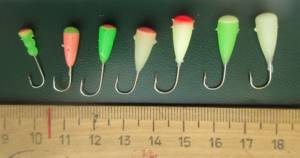
Another interesting type of smelt bait that has appeared in the last 10 - 12 years is LED assemblies (photo 9) . They are not as miniature as classic jigs.

Having received voluminous fishing statistics over the years in different conditions, I can say that although this is not a panacea for lack of biting, and they bite no more often than classic lures, they do bite on those fishing rods that have at least one such electronic jig in the equipment , there are almost twice as many bites as on those where there are none. Moreover, the only jigs that didn’t work very well for me were those with continuous light. And flashing lights with any flash frequency and duration, as well as any brightness, attract fish. But the priority of some of these indicators turned out to be new almost every fishing trip.
Summing up the interim results on the baits, I determined the following for myself. In order to still be in the legal field and not produce several dozen fishing rods with all these equipment options, I stocked up on a box in which I carry already prepared stakes with baits on long reels (photo 10) . And you can change them on the ice, selecting the necessary jigs, in a minute. The fasteners at the ends of the stakes also allow you to quickly select and replace a sinker or end spinner, which combines the functions of bait and sinker.

Speaking about fishing rods, I cannot ignore the use of small flexible 2-3-arm telescopes equipped with reels for smelt fishing. But not simple wiring ones, but inertia-free (photo 11) or multiplier ones. I first saw such gear about 20 years ago in some American documentaries about fishing for bass and pike perch from ice. A little later the thought arose, why not use them when catching smelt? And first, a couple of experienced working prototypes went smelt fishing with me, and then a full arsenal was built, which clearly won the competition against the classics.
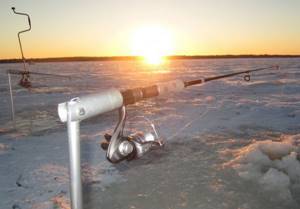
The difference from classic gear is that with this gear, the catch is retrieved not by picking out the fishing line with your hands, but using a reel. Due to the reduction of the reel and the presence of a friction clutch on it, the speed of reeling out the line is comparable to how everything is taken out by hand, and in some cases even higher. And when instead of smelt there was some nice by-catch, there was almost no chance of getting off. My first homemade fishing rods of this type are more than ten years old, but they all work great and were even tested by my friends when fishing in a tent, including at night.
And modern manufacturers have already launched the production of one- and two-part winter spinning rods. Their main purpose is the vertical trolling of pike perch and trout on the “platforms” and even perch on the “Balda”. Among the proposals, I can highlight Stinger ForceAge Ice (photo 12) and Maximus Revolt Ice Sport Pro (photo 13) . However, after trying these spinning rods a couple of times for smelt fishing, I came to the conclusion that they are suitable for this too.
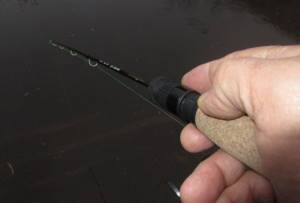
Light models can be taken without modifications, but for medium and heavy models it is worth considering installing a nod. It must be done in such a way that even the most careful bite does not go unnoticed. In addition, these fishing rods, without resetting, allow you to catch fish not only from the bottom, but also in mid-water, where it can sometimes be located. At least on about 20 - 30% of fishing trips it is possible to find it there. These fishing rods can be used with both small spinning reels - for example, Stinger Arctic Char Spin SRL AC1000 (photo 14) , and with multipliers like Black Side Ice Zeal BSIZ60 (photo 15) .

By the way, when using such gear with reels, you should pay special attention to securing the end weights. Without good swivels on them, after several landings of large smelt, the line begins to seriously twist, which needs to be watched. Therefore, either good swivels, or, from time to time, lowering the fishing line into the hole, you need to let it unwind on its own.
And here I want to place special emphasis on the fact that such modern fishing rods are ideally suited for fishing in a tent. The hook is more confident and reliable, and it can be done while sitting on a chair.
When reeling in the fishing line, you don’t have to worry about getting tangled, even if you start biting on all the fishing rods at once. Placing the fishing rod in “combat cock” also does not require control, and the line coming off the spool in automatic mode occurs noticeably faster than on classic fishing rods, when this process is difficult and sometimes unrealistic to carry out without the help of a fisherman. The presence of a friction clutch makes it possible to use thinner fishing lines. And you can fish with such fishing rods in conditions of minimal light, and even in the dark. In general, when fishing at night in a tent, it’s difficult to come up with something more convenient.
As for ensuring good lighting, I tried all sorts of LED devices while fishing - and came to the conclusion that I needed one, but one that could solve several problems at once. It must have a bright, highly directional beam, i.e. work in the "lamp - headlight" mode. The beam is better wide, illuminating as much surface as possible under your feet. Well, if possible, the lamp should be a good signaling device. And, for example, the Stinger Prolight - a universal headlamp PRL-33160 (photo 16) - also has a UV source, which allows you to quickly recharge jigs and spinners with a light-accumulating coating.

I’ll supplement the story about smelt baits with a description of such effective models as a spinner or a balancer, which I discovered for myself back in the mid-80s of the last century. Then, however, we had to interfere with the design of the spinners of that era and apply a layer of epoxy resin with a phosphor to one of the surfaces of the spinner (photo 17) .
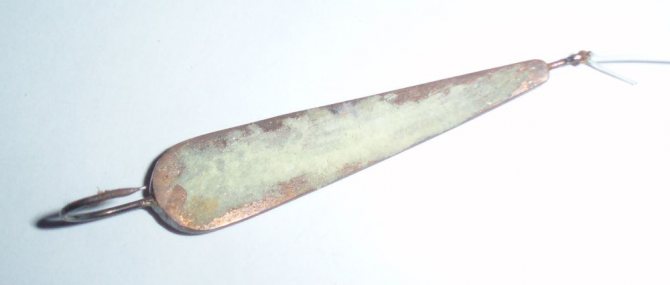
But with the advent of luminous and fluorescent baits - say, balancers from Nils Master (photo 18) and spinners of the same name (photo 19) - the selection of baits necessary for smelt has become noticeably simpler.

All that remains is to correlate the size with the fishing depth and prepare a light fishing rod for trolling. And in recent years, the choice of such baits has expanded significantly. Several worthy models with applied phosphor have appeared - for example, a rather large line from “Northern Workshops” (photo 20) .
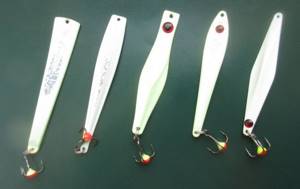
I would like to especially note that I also use spinners on a purely spinner fishing rod, which I work with while the classics are “silent”, and lately - also as end weights on fishing rods with reels. They perform both the function of bait and the function of attractants. I took it off the tripod, played with the lure, and put it in place. Sometimes it is this action that produces tangible results.
And about bait. Smelt does not respond to the “rewinder”. Despite my several attempts to fish with baitless baits of different sizes and colors at different depths and in different conditions, the result was zero. But as soon as you added a small piece of organic matter to the hook, the smelt showed itself almost instantly.
Experiments with organics turned out to be multifaceted; I tested a lot, from chicken and beef offal to the meat of noble species of fish. It bites on everything, but the priorities are very noticeable, especially if you look at the statistics for several years. In general, I support the conclusions of many fishermen that in many cases smelt especially excretes the meat of carp fish.
It is worth mentioning here that the meat must be fresh and not frozen. I usually prepare a jar of cut bait the night before, forming cubes of various sizes. I store it overnight and take it to the car in a cold place without freezing. And on ice I’m just putting it on. I was surprised to see how some fishermen bring live fish onto the ice and cut them up before fishing. Some people start smelt fishing by catching perch near the shore. But as statistics from joint trips show, crucian carp cooked at home is no less effective.
As an addition, I note that sometimes attractants such as fish blood or perch caviar tied in a tiny nylon bag to a sinker also work. The topic of the smelt “feeder”, which I described several years ago, lives on and sometimes gives good results (photo 21) .
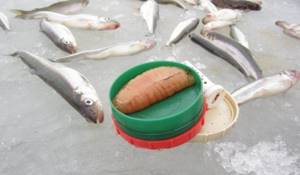
And finally, about safety. As I wrote above, shipping to the south of Kronstadt has recently become noticeably more active. And during severe and prolonged frosts, icebreaking equipment is constantly scurrying around there. This creates large clearings, free of ice, not only on the fairway itself, but also at some distance from it (photo 22) .
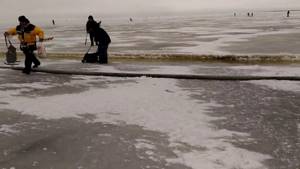
The ice shell in the southern part of the Dam is weakening, especially closer to spring, which, together with increased winds from the southern and eastern directions, increases the chance of large ice floes breaking off and subsequently sailing away. And the thickness of the ice in this part of the bay rarely exceeds 20 - 30 cm. Approximately the same picture is observed in the spring behind the Tolbukhin lighthouse, where motorized smelt lovers often visit. It’s one thing if the company arrived by airboat (photo 23) , and quite another thing if it arrived on snowmobiles or “motorized dogs”.
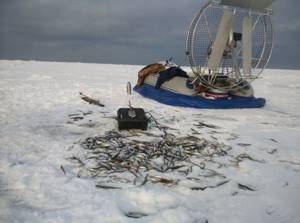
Closer to the Dam in its northern part in the spring the situation is calmer and more predictable. The only thing that can cause concern is ice in the area of culverts. In the spring it erodes noticeably faster there.
By tracking the reports of smelt fishing regulars on social networks and preparing a set of gear and bait for current fishing conditions, you can safely expect that after a day spent in the fresh air, you will be able to organize a small celebration at home and please your family with a delicious fish with a cucumber scent.
Bait for catching smelt in winter
Now let's discuss what to use to catch smelt in winter:
- crucian carp
- smelt
- eel-pout
These are the main baits when fishing for smelt.
All season I bought fresh crucian carp for bait, cut it up in the evening and put it in the refrigerator, but many anglers cut it up right on the pond, it’s their choice, I don’t really like this method. After all, it’s not enough to clean the crucian carp; it needs to be cut into small pieces less than one centimeter.
The only thing I cut at the hole is freshly caught smelt. One day I failed to find crucian carp in the city, and I cut up a perch that I had caught the day before on Lake Ladoga. I thought the fishing would be ruined, but imagine my surprise when I realized that I caught it no worse than crucian carp. But I wouldn’t be me if I hadn’t experimented. I cut up a freshly caught smelt and put it on half of the fishing rods; the bite was even on all of them. And I calmed down. But, nevertheless, I wanted to buy fresh crucian carp before fishing.
Sometimes the by-catch includes a fish like the Eelpout. Some anglers consider it a real treasure. They say it stays on the hook better than crucian carp and it bites simply phenomenally. I didn’t catch it, or rather I didn’t come across it, so I can’t say anything, but I’m sure I’ll experiment in the future.

Eelpout fish is considered the best bait for catching smelt
Reports on smelt fishing in the Gulf of Finland
In this section I will post reports on my smelt fishing trips.
Catching smelt from a boat on the Gulf of Finland
Hunting is worse than captivity, in St. Petersburg it is already December 28, 2021, and there is still no ice. The feeds of fishing groups are full of reports of smelt fishing in the Gulf of Finland. And we go fishing, the purpose of this trip is, of course, smelt. But this time we will catch it not from the ice, but from a boat. This is my first experience of such fishing and, as usual, I made a lot of mistakes, which I will share with you in this short report.
And now, in order. We decided to fish on the old fairway of the southern dam of the Gulf of Finland. For those who don’t know where it is and how to comfortably get the boat there without breaking your legs on the rocks, I’m attaching a diagram.
Having reached the place where the boat was launched, an amazing picture opened up on the shore; I had never seen so many fishermen even in summer. The entire shore was dotted with smelt hunters.
While they were pumping up the boat, I managed to watch the fishermen. They had rare bites, but sales suffered; I didn’t catch a single fish. And looking ahead a little, I’ll say that the guys who were fishing from the shore, caught very poorly this time, literally 5-10 tails each.
And we begin to lower the boat. On this day it froze a little and all the coastal stones were covered with a layer of ice. And the fact that we didn't break our legs lowering the boat was a miracle. Having carefully lowered the boat, within a few minutes we found ourselves on the old fairway and anchored at a depth of 10 meters. Now you can start fishing.

Somehow I didn’t prepare particularly for this fishing and took only a set of winter gear with me, which I very much regretted. For some reason, it seemed to me that I would select tackle from the depths with my hands, just like in winter. But when fishing from a boat, this does not work and you can easily confuse and break everything. So the best option is to use an onboard fishing rod with a spinning reel. I don’t have to choose, I fish with what I have.
At first it was very difficult to adapt to the work of the nod; it constantly played when the boat rocked, and the rocking that day was not weak. It seemed to me that it was constantly biting, but after an hour I could confidently distinguish a bite from parasitic vibrations of the nod. My friend used a short telescopic rod with an inertia-free reel and he was much more comfortable fishing than I was. I wore out my fingers, constantly reeling out 10 meters of fishing line onto a small reel of a winter fishing rod. And I had to reel it in often; the smelt pecked well, even in raids with short pauses.
As a rig, I used my classic winter version:
- bell weight 25 g, although heavier ones can be placed from a boat;
- 3 phosphorus jigs on 3 cm leads;
- main line 0.25 mm. ;
- leash 0.16 mm.
But this time I installed new, handmade jigs on high-quality Owner hooks. And I’ll tell you this, I didn’t have much more bites than my partner, who used standard factory jigs, but the implementation was simply colossal, which pleasantly surprised me.

Still, high-quality Japanese hooks do their job. Also, I used three different jigs, but 90% of the fish were caught on one. It is not clear what this is connected with, either with its color, or with the fact that it was closest to the bottom.
And I also want to say about the gear and fishing efficiency. If my partner and I were biting and hooking at the same time, then while I was reeling out my tackle, he had already managed to pull out the tackle, remove the smelt, attach the crucian carp and cast again. And I’m not exaggerating, that’s how it happened. So, if I had thought about this earlier, the catch would have been a little larger, as it was, a modest 96 smelt.
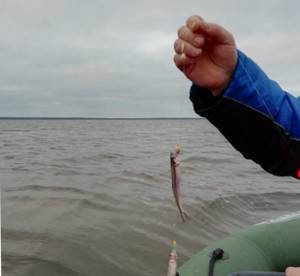
And also, dear friends, dress warmly. Since you hardly move in the boat, you freeze very hard and quickly. And I don’t really want to go to the shore and climb on these slippery stones again.
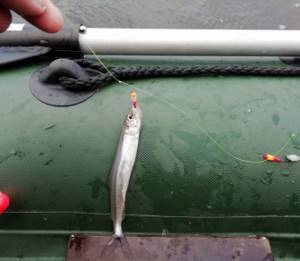
Fishing for smelt in the Gulf of Finland 2020
Another trip for smelt. It’s already January 11th in St. Petersburg, and there’s no smell of ice, there’s a steady plus in the city and region.
Unlike the last fishing trip, I prepared thoroughly for this one. I bought a short plug-in spinning rod 1.2 m, this is what I need for fishing from a boat.
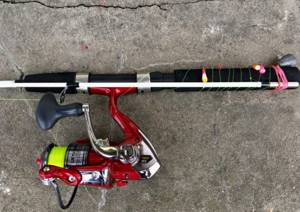
An inertia-free reel of size 1000 so that the line does not hit the small rings of the side.
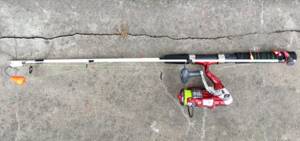
Beadboard for smelt
And I rewound all the equipment from my winter fishing rod, which I fished with last time. Let me remind you that this fishing rod had handmade jigs of different colors and only one color worked - red. At the time I was wondering what it had to do with the color or the fact that it was the lowest jig. So I tied the jig and made it second from the bottom.

The preparations are over, all that remains is to go and catch some fish.
As always, we are going to the southern dam of the Gulf of Finland. Unfortunately, the weather was bad today; a strong westerly wind did not allow us to go out to the sea side of the dam. But there is nothing to do, there is also smelt on the city side, we go out onto the old fairway. We arrived at the point at 7 am, anchored at a depth of 13 meters and started fishing. Half an hour has passed, we are not upset, we have never had a bite in the first minutes. But an hour passes, two, three, and still no bites. This is nonsense, I have never had anything like this. Meanwhile, it has long since dawned and you can look around.
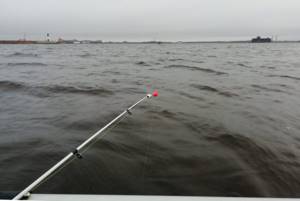
There are about 50 boats around us and no one is biting. Some sit still, others constantly move in search of smelt. But the fact remains that the smelt refuses to peck at all. At one o'clock in the afternoon we decided to take a break and go ashore to warm up. On the shore I asked the fishermen how things were going with the bite. And they weren’t surprised by the answer - one bite, two breaks in the gear. At the same time, the fishermen did not disperse, everyone was waiting for the bite to start. After all, it can’t be that a schooling fish doesn’t bite all day.
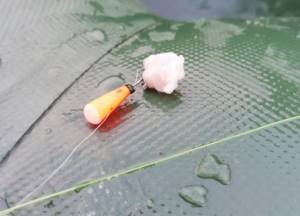
By two o'clock we reached the point again and lo and behold! The bites started. Rare, but they have begun. In two hours I caught 8 smelt, my partner 2. And again I had only one jig, my catchy “saffron milk cap,” working for me. 6 pieces were caught on it, one on the top and one on the bottom. The statistics are of course so-so, but if there is still ice, I will make 2 fishing rods exclusively with jigs in this color.
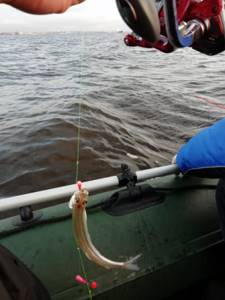
This was the end of our fishing; we no longer had the strength to freeze in the boat.
I wish you good luck and big catches.
